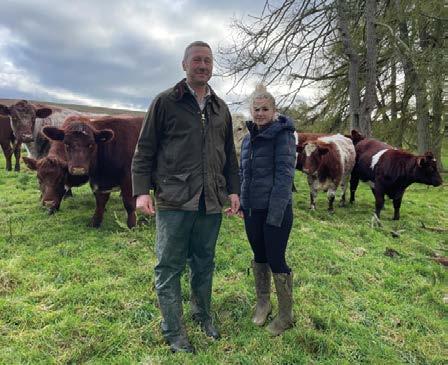
3 minute read
Yorkshire: Beef Shorthorns in a Countryside Stewardship agreement
Beef Shorthorn, an efficient modern functional suckler working in its native north east
Peter Turnbull says he feels as well placed as any suckler producer managing transition to the new support system thanks to a decade of experience successfully farming purebred Beef Shorthorns in a Countryside Stewardship agreement.
Advertisement
30 Beef Shorthorn cows and in calf heifers
12 Beef Shorthorn heifer replacements / for sale
1,300 ewes and 350 ewe lambs
1,500ha moorland over two farms
“We’ve learned about reducing inputs and stocking at very low rates to match the scheme’s Higher-Level requirements, yet we’re farming cost effectively and producing hardy, healthy cattle from the top of the North Yorkshire moors at an average 750 feet,” he explains.
“Our Beef Shorthorn have proved to be modern, functional suckler, they’re natural, easy fleshing cattle, thriving on pure forage diets in a very marginal system.” The main portion of the herd is grazed at approximately 1LU/2.5ha in species rich woodland which also provides an environment for nesting wading birds.
“We would out winter the herd if practical, however this unit is extremely exposed to biting easterly winds and the risk of poaching makes it impractical for us to feed supplementary forage, so we house on pure forage diets for approximately 16 weeks until straight after calving in April. Same applies to the heifers, we don’t feed any creep, we like to naturally grow them on to calve at three years.
“Furthermore, we’re breeding a moderate 650-700kg cow - she’s more active, eats less and minimises poaching enabling us to keep the herd out longer whilst leaving more grass for the sheep to tidy up,” comments Peter from his home base at West House Farm, Kildale.
Herd fertility is reflected in the fact 90% calves within the first three weeks, and virtually the entire herd with the next cycle. “We like to calve and lamb at the same time whilst we’re around all the time, however we’ve found our Beef Shorthorns to be easy calving and they’re good mothers with plenty of milk, traits that set native breeds apart from the rest.”
Peter swapped a Continental cross suckler herd producing stores for Beef Shorthorn back in 2010 investing in genetics from Endeavour, Glengoy and Upsall. Blelack Masterpiece stamped his hallmark on the Oakleigh herd. “We used to buy in Continental cross cows with calves at foot when we needed to, however we found we were buying in health issues. Furthermore, we’d had the odd incident with our Continental cows and with labour being scarce, we wanted something with a better temperament.
“When we took on a Forestry Commission unit tenancy and entered the 10-year Countryside Stewardship Higher Level agreement it provided a new opportunity. We decided to stock a native breed to meet with its requirements. We looked at them all and eventually decided Beef Shorthorns had the most going. These cows were quiet, had the polled factor, and the breed had the added interest of being the most native to this region yet it had evolved to be a modern functional suckler. herd provided the opportunity for closing it down.” Oakleigh joined up a CHeCS health scheme in 2013 and has since achieved elite health status, being accredited free from BVD, IBR and Lepto and Johne’s Level I.
“Having decided Beef Shorthorn should fit our ground, that’s proved to be the case, and it doesn’t stop there.” The breed’s impact at West House Farm is having a ripple effect in the region, he says.
“There’s a real growing demand here for Beef Shorthorn. Whilst we’ve traded heifers to a top of 6,500gns in Carlisle and I like to continue to support the marts, we’ve sold several bulls to suckler producers farming within a 20-mile radius of the farmgate. They too are seeking to introduce more milk, easier calving, reduced mature cow size and better temperament to their Continental cross herds since they’ve less labour on farm and they don’t want to buy a bull in the mart that’s been presented as overfed. I’m finding they return within two or three years to buy some heifers,” he says adding: “I’m confident that trend will continue as we rapidly head towards full introduction of the new payment system. I believe we have in Beef Shorthorn a modern functional suckler suited to the future.”
Peter Turnbull and his niece, Neve Hodgson who works part time on the farm 240ha in bye grassland over three farms
Blackface and Swaledale run on the moor, drafts and Mules on bye. Blackface and Bluefaced Leicester tups sold for breeding purposes.








